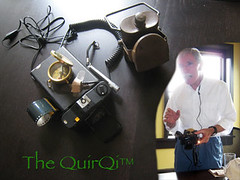QuirQi: my analog solution to digital challenge
July 10th, 2007 by Bill
 As the unabashedly analog guy in this resolutely digital company (heck, I used to be a banker before I became an honest business man!), I simultaneously marvel and despair at encounters with cutting-edge technology: How do software and hardware engineers do that stuff, and why can’t I? OK, so I’m pretty good now with my digital camera, and just succumbed to the siren song of Apple and bought an iPhone. But I still use a 70-year old fountain pen, a 50-year old Leica, and have a funky leather saddle (Brooks, of course) on my titanium road bike.
As the unabashedly analog guy in this resolutely digital company (heck, I used to be a banker before I became an honest business man!), I simultaneously marvel and despair at encounters with cutting-edge technology: How do software and hardware engineers do that stuff, and why can’t I? OK, so I’m pretty good now with my digital camera, and just succumbed to the siren song of Apple and bought an iPhone. But I still use a 70-year old fountain pen, a 50-year old Leica, and have a funky leather saddle (Brooks, of course) on my titanium road bike.
Having sat in on many meetings here at Exbiblio listening to the engineers discuss progress (and occasional setbacks) on optical scans, illumination pathways, processor speeds, memory, networking, etc., none of which I can contribute to, I decided I could quickly cobble together the analog version of the very sophisticated “Qi” device the team is building. Thus, the stunningly simple device pictured here, immediately and cleverly dubbed by Mark Sanvitale as the “QuirQi.” All the core, “Qi” features are here: scan camera with highly advanced sensor material (otherwise known as B&W Film), reliable illumination source (absolutely bullet-proof MiniMaglite), a compass to add location context to the scan, earplug with mic for voice annotations, “scan-in-progress” warning flasher, etc… And, of course, the “black box” inside of which strange and wonderful – if analog – things take place. All of the components of QuirQi were found gathering dust under my home workbench, thus proving that analog guys can hold their own in the digital age. Who needs C++ anyway?
